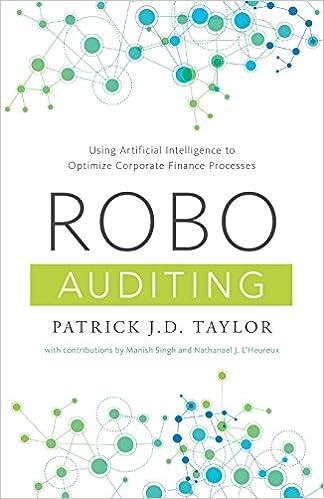Question
2. Effect of management decisions on ratios (20 points) Most decisions made by management impact the ratios analysts use to evaluate performance. Indicate (by letter)
2. Effect of management decisions on ratios (20 points)
Most decisions made by management impact the ratios analysts use to evaluate performance. Indicate (by letter) whether each of the actions listed below will immediately increase (I), decrease (D), or have no effect (N) on the ratios shown. Assume each ratio is less than 1.0 before the action is taken.
Current Debt to Action ratio equity ratio
1. Issuance of common stock for cash ____ ____
2. Purchase of inventory on account ____ ____
3. Receipt of cash from a customer on account ____ ____
4. Expiration of prepaid rent ____ ____
5. Payment of a cash dividend ____ ____
6. Purchase of equipment with a 6-month note ____ ____
7. Purchase of long-term investment for cash ____ ____
8. Sale of equipment for cash (no gain or loss) ____ ____
9. Write-off of obsolete inventory ____ ____
10. Decision to refinance on a long-term basis
currently-maturing debt ____ ____
3. Income statement (25 points)
Selected information about income statement accounts for the Ajax Company is presented below for the fiscal year ended December 31, 2016.
Sales .................................................. $6,200,000
Cost of goods sold ............................. 3,500,000
Administrative and selling expenses ... 1,500,000
Several events occurred during 2016 that have not yet been reflected in the above accounts:
1. A landslide caused $75,000 in uninsured damages to a warehouse. The landslide was considered to be an infrequent but not unusual event.
Interest revenue in the amount of $100,000 was earned.
The company incurred restructuring costs of $250,000.
Interest expense on debt totaled $150,000.
Investments were sold for a loss of $40,000.
Required: Prepare a multiple-step income statement for the Ajax Company for the year 2016, including income taxes computed at 40%. Ignore EPS disclosures.
4. Discontinued operations (20 points)
The Ottoboni Corporation had two operating divisions, one manufacturing division and a finance division. Both divisions are considered separate components of the entity. The finance division has been unprofitable, and on October 3, 2016, Ottoboni adopted a formal plan to sell the division. The sale was completed on March 19, 2017. At December 31, 2016, the division was considered held for sale. On December 31, 2016, the companys fiscal year-end, the book value of the assets of the finance division was $2,100,000. On that date, the fair value of the assets, less cost to sell, was $1,900,000. The before-tax operating loss of the division for the year was $270,000. The companys effective tax rate is 40%. The after-tax income from continuing operations for 2016 is $600,000.
Required:
1. Prepare a partial income statement for 2016 beginning with income from continuing operations. Ignore EPS disclosures.
2. Repeat requirement 1 assuming that the estimated net sales price of the finance divisions assets was $2,400,000, instead of $1,900,000.
Step by Step Solution
There are 3 Steps involved in it
Step: 1

Get Instant Access to Expert-Tailored Solutions
See step-by-step solutions with expert insights and AI powered tools for academic success
Step: 2

Step: 3

Ace Your Homework with AI
Get the answers you need in no time with our AI-driven, step-by-step assistance
Get Started


